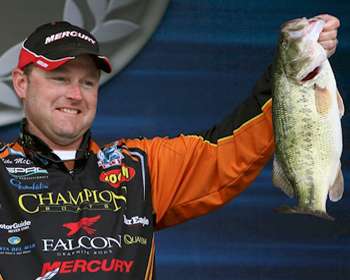
Elite Series pro Mike McClelland has won tournaments under varying conditions and in locations across America. One credit to his success in varying bodies of water has been his diligence in seeking offshore locations that attract and hold bass.
For McClelland, one of his favorite types of offshore cover is a man-made brushpile, but unless he's the one who planted it, locating one can be akin to finding the proverbial needle in a haystack.
"The truth is that with today's technology, it's much easier to find rock and brushpiles than it was even five years ago," he explains. "You can now cover so much water in less time because of it, but you first have to determine the depth that most brushpiles are placed."
Determining the prevailing depth range is key and, as McClelland suggests, if you do your homework, it's often easy to determine seasonal patterns. "Take Lake of the Ozarks as an example. That's a lake where anglers typically catch a lot of fish in 6 to 8 feet of water in the spring," he says. "That's where most of the brushpiles will be, so that's where you need to start looking."
The same relative theory holds true at lakes across the county. "Usually, brushpiles are placed for an upcoming tournament," he points out. "Since most tournaments around the country are either mid- to late-spring or summer, you know that you're going to be pretty safe to start in 15 feet and work up to around 6 (feet)."
Late-summer brushpiles will typically be placed in 25-foot depths, but the same methodology applies. "If you're looking later in the spring or in the summer, you're going to be keying on secondary points and out to the main lake," he explains.
"If you start at the first substantial dropoff and idle through water in the same general depth, it's a pretty good bet that you'll find a brushpile. You just have to keep your eyes on the electronics." In the event that you're not able to determine the likely depth, McClelland advises to keep an eye peeled to the shoreline for clues.
"One thing that you have to keep in mind, especially on lakes that have a lot of timber around the shoreline, is that you'll usually see signs of a brushpile," he reveals. "If you see a willow tree stump on the bank for example, you have a good clue there's a brushpile close by."
McClelland explains that his tried-and-true method for finding brushpiles was born in the days before GPS was available. "Back then, you had to visually see the point and pick your line and just work around it," he explains. "Once you found a little brushpile, you'd then have to triangulate its location.
Now, with side scanning GPS units, the process is so much easier. You can go out in practice and find 15 or 20 brushpiles on the first day, if that's what you're looking for." Perhaps the easiest way to find a productive brushpile, as McClelland points out, is to simply plant your own. "If you have the time, that's by far the most effective way to have a brushpile that will produce," he says.
"There's a lot of work involved in getting the right set up, but that's another story."
(Provided by Z3 Media)




